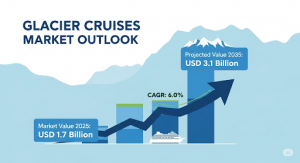Overview of the Glacier Cruises Market
The glacier cruises market is on a trajectory for significant growth, projected to increase from USD 1.7 billion in 2025 to an impressive USD 3.1 billion by 2035. This translates to a compound annual growth rate (CAGR) of 6.0%. Such developments are closely tied to the rising interest in sustainable travel and the allure of immersive experiences offered by these extraordinary journeys through some of nature’s most awe-inspiring landscapes.
Market Drivers: Sustainability and Experience
The current market growth can be attributed to multiple factors, primarily the demand for sustainable, nature-centric tourism. Eco-conscious travelers seek genuine interactions with untouched landscapes, enhanced by onboard educational programming and guided excursions. Furthermore, innovations in low-emission vessel technology and investments in ice-class ship design are paving the way for extended operational seasons in remote icy destinations.
Another driving force is the digital transformation in the travel industry. Online bookings are forecasted to contribute 54% of market revenues by 2025, relying on increasingly user-friendly cruise line websites and aggregator platforms that offer personalized itineraries and transparent transactions. Social media also plays a crucial role, providing travelers with vivid visuals and real-time reviews that significantly influence their journey choices.
Regional Insights: Alaska’s Dominance
Alaska is set to lead the market with a commanding 36% share by 2025. Its vast glacial coastline and diverse wildlife, coupled with a robust tourism infrastructure, make it a prime destination for glacier cruises. The region’s collaborations with local tourism boards and timely scheduling of cruise operations during peak glacier viewing seasons continue to bolster its appeal to both first-time and repeat visitors.
Attracting International Travelers
The international tourist’s role is pivotal, accounting for an anticipated 61% of revenue in 2025. High interest is expected from Europe and the Asia-Pacific region. These globally minded travelers often pursue extensive itineraries that balance cultural experiences with environmental education. In response, operators are enhancing language support and regional dining experiences while offering bundles that include logistics, facilitating access to often isolated glacier regions.
Innovations in Experience and Product Offering
To stay competitive, glacier cruise operators are focusing on multi-layered adventure experiences. Activities now commonly integrated into itineraries include:
- Rafting and ATV tours in remote areas
- Camping and whale watching excursions
- Helicopter tours over glaciers
- Educational programs aimed at raising awareness about climate change and wildlife preservation
Such immersive experiences are tailored not just for leisure, but also as engagement tools to foster connection with the environment, reiterating the urgency of conservation.
Market Challenges: Seasonal Constraints and Environmental Risks
Despite the rosy outlook, challenges remain. Operations for glacier cruises are largely confined to the May to September period in various regions, with unpredictable weather and ice conditions often limiting accessibility. Climate change poses another serious concern, with glacial retreat threatening the unique landscapes that form the foundation of this cruise segment.
Addressing environmental impacts is critical, as governments in regions like Greenland scramble to implement measures aimed at managing the burgeoning tourist influx while safeguarding vulnerable ecosystems. This balancing act between growing demand and environmental preservation is becoming increasingly common across the industry.
Understanding Consumer Behavior
Seniors aged 46-65 have traditionally made up a significant demographic for glacier cruising, but there’s a noticeable shift as younger generations and families gear up to join the fray. This multigenerational trend is being driven by the desire for adventure in less-visited areas and witnessing rapid environmental changes up close. Recognizing booking trends, travelers prioritize online convenience and often opt for packaged deals that deliver cost savings paired with curated experiences.
The Competitive Landscape
The glacier cruise market features a number of prominent players, each vying for a share of the growing demand. Operators differentiate themselves through:
- Adventure-focused excursions, such as glacier hiking and camping
- New routes exploring untouched glacier territories
- Cultural experiences enhanced by local cuisines and partnerships
- Creative digital marketing strategies that highlight the beauty and essence of destinations
Notably, Carnival Cruises is currently offering exclusive glacier packages that combine adventure with luxury dining, appealing to a wide range of travelers.
Future Intentions: A Strategic Focus for 2025-2035
Looking ahead, strategies that industry manufacturers, operators, and destination managers will need to adopt include:
- Utilizing eco-friendly technologies to align with consumer values.
- Investing in unique, immersive experiences tailored to enhance the glacier cruising journey.
- Embracing flexible sales models that connect with travelers digitally.
- Building local partnerships to enhance sustainability and cultural authenticity.
Implementing these strategies will not only ensure that the glacier cruise market continues to thrive, but it will also protect the fragile environments that make these journeys so special.
For destinations where yachting and sailing adventures are in high demand, GetBoat.com serves as an international marketplace for renting sailing boats and yachts, perfectly suited for various preferences and budgets. As the glacier cruise market evolves, leveraging these advances in eco-tourism will ultimately provide exciting opportunities for travelers eager to experience the beauty of our planet’s icy realms.

 Soaring Demand for Glacier Cruises: A Future Perspective">
Soaring Demand for Glacier Cruises: A Future Perspective">
